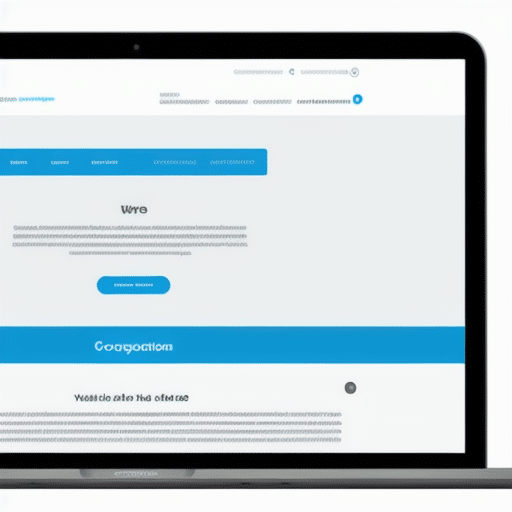In the design world, a key element for the development of digital projects is the wireframe.
But what exactly is a wireframe and why is it so essential in the design process? In this article we will explore the basics of wireframes, their benefits in design, how to create them effectively, the different types of wireframes and when to use each one, as well as the most popular tools for designing them.
We will also discuss the importance of collaboration in wireframe design and look at some inspiring examples of successful designs.
Join us on this tour through the fascinating world of wireframes and discover how they can enhance your digital design projects.
What is a wireframe and why is it essential in design?
A wireframe is a basic visual representation of the structure and layout of a website or mobile application.
It consists of a simplified outline showing the key elements of the interface, such as buttons, text fields, images and other graphical elements.
Essentially, a wireframe is the skeleton of a web page or mobile application.
It is important in design because it helps designers visualize the structure and flow of the page before moving on to the full design.
In addition, wireframes are useful for obtaining early and valuable feedback from users and project stakeholders.
By creating a wireframe, designers can focus on information architecture and functionality rather than worrying about superficial details such as colors or fonts.
Wireframes are also useful for collaboration between designers and developers, as they provide a solid basis for working as a team.
In short, wireframes are essential in the design process because they help designers plan and organize the structure and functionality of a website or mobile application before moving on to the full design.
The benefits of using wireframes in the design process
Wireframes are an essential tool in the design process.
By using them, designers can visualize and plan the structure of a website or mobile application before starting to work on its visual design.
This allows usability and navigation problems to be detected before time and resources are invested in creating a complete design.
In addition, wireframes help designers communicate better with their clients, as they can easily understand the structure of the project without being distracted by visual details.
Wireframes are also useful for setting project priorities, as they allow designers to focus on functionality and user experience before worrying about aesthetics.
Another important benefit is that wireframes facilitate collaboration between team members, as everyone can clearly see the structure of the project and make specific suggestions and comments.
In summary, using wireframes in the design process can save time and resources, improve communication with clients, establish clear priorities, and foster effective collaboration among the team.
How to create effective wireframes: best practices and tips
Creating effective wireframes is a crucial step in the design process.
A good wireframe should be clear, easy to understand and accurately represent the structure of the website or application.
To achieve this, it is important to follow some best practices and tips.
First, it is essential to clearly define the project objectives and have a clear understanding of the user's needs.
Then, start by creating a basic outline of the structure of the site or application, identifying the different sections and pages that are needed.
It is important to pay attention to the visual hierarchy, making sure that the most important elements are the most prominent.
It is also advisable to use a limited color palette to avoid unnecessary distractions and focus on the functionality of the design.
In addition, it is important to keep in mind that content is key: wireframes should include sample text to get a clear idea of what the final design will look like with real content.
Finally, it is important to receive comments and feedback from other members of the design team or even end users to ensure that the wireframe is effective and meets your objectives.
By following these practices and tips, you can create an effective wireframe that is the solid foundation for a successful design.
Different types of wireframes and when to use each one
There are different types of wireframes that can be used in the design process, and each has its specific purpose.
Low-fidelity wireframes are simple, basic sketches used to represent the general structure and layout of a page or application.
They are ideal for the initial design phase, as they allow designers to experiment with different ideas without wasting time on minute details.
On the other hand, high fidelity wireframes are more detailed and more similar to the final product.
These wireframes include visual elements such as colors, typography and actual content, giving designers and clients a clear idea of how the final product will look and function.
In addition, there are also interactive wireframes, which add functionality to static elements.
These wireframes allow designers to simulate the user experience when clicking on buttons or interacting with drop-down elements.
They are especially useful for testing the navigation and usability of a website or application before moving to the development stage.
Choosing the right type of wireframe depends on the objective of the project and where you are in the design process.
Low-fidelity wireframes are useful for exploring initial ideas and getting quick feedback, while high-fidelity wireframes are better suited for presenting final designs and getting final approvals before moving to the development stage.
Interactive wireframes are useful for simulating the user experience and testing the functionality of the design.
Ultimately, the choice of wireframe type will depend on the specific needs of the project and the preferences of the design team.
Popular tools for designing wireframes
There are several popular tools that designers use to create wireframes, which allow them to visualize and plan the structure and functionality of a design before moving to the development stage.
One of the most popular tools is Axure RP, which offers a wide range of functions for creating interactive wireframes and prototypes.
Another popular option is Balsamiq, which stands out for its simple interface and its ability to quickly create wireframes with predefined elements.
Sketch is another tool widely used for its focus on user interface design, allowing designers to create detailed wireframes with ease.
In addition, Adobe XD is a popular choice because of its integration with other Adobe tools and its ability to create interactive wireframes and prototypes.
There are also free options, such as Figma, which allows users to teams collaborate in real time in the creation of wireframes.
These tools offer a variety of functions and features that facilitate the design process and enable designers to communicate their ideas effectively.
It is important for designers to find the tool that best suits their needs and preferences, as each has its own advantages and disadvantages.
By utilizing these popular tools, designers can streamline their workflow and create effective wireframes that help drive project success
The importance of collaboration in wireframe design
Collaboration plays a key role in wireframe design, as it allows design and development teams to work together efficiently and effectively.
In the design process, collaboration fosters communication and the exchange of ideas among team members, resulting in the creation of stronger, more functional wireframes.
Collaboration in wireframe design involves different stakeholders, such as designers, developers, usability experts and customers.
Each of them brings their experience and expertise to ensure that the final wireframe meets the project objectives and user needs.
Working as a team allows for a broader and more diverse vision of the project.
Different points of view can help identify potential problems and find creative solutions.
In addition, collaboration facilitates the decision-making process, as different options can be discussed and evaluated before a final solution is reached.
Collaboration also promotes transparency and accountability in the design process.
By working together, team members can share their ideas and receive constructive feedback, which helps improve wireframe quality.
In short, collaboration is essential in wireframe design.
Facilitates communication, encourages creativity and ensures that the end result is a solid, functional wireframe that meets project objectives and user expectations.
Inspiring examples of successful wireframe designs
Inspiring examples of successful wireframe designs are an excellent source of inspiration for designers and UX professionals.
These designs stand out for their clarity, efficiency and ability to convey information effectively.
An example is the wireframe used by Airbnb in its mobile application.
This wireframe has a clear and simple structure that allows users to easily navigate through the application and find what they need quickly.
Another successful example is the wireframe used by Google Drive.
This design has a simple and consistent color scheme, which makes it easy to read and understand the information presented.
In addition, the design uses intuitive icons to represent different actions, allowing users to interact with the application without having to read extensive instructions.
Another prominent example is the wireframe used by e-commerce platform Shopify.
This design has a clear and simple navigation that allows users to access different sections of the website quickly and easily.
In addition, the design uses effective visual elements to highlight the most important products and promotions.
In summary, these inspiring examples of successful wireframe designs demonstrate the importance of efficient and thoughtful design in the success of any online product or service.
In short, wireframes are an essential tool for any designer looking to create effective and satisfying user interfaces.
From its ability to save time and money to its ability to foster collaboration and communication among team members, the benefits of using wireframes in the design process are innumerable.
By knowing the best practices and tips for creating effective wireframes, as well as the different types of wireframes and when to use each, designers can ensure that their designs are visually appealing and easy to use.
In addition, popular tools for designing wireframes make the process more accessible than ever.
However, despite all these technological advances, the importance of collaboration in wireframe design remains critical.
Ultimately, the success of a project depends not only on the quality of the design itself, but also on the ability of the team to work together and communicate effectively.




